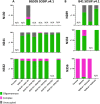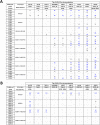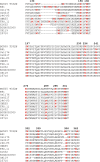Closing and Opening Holes in the Glycan Shield of HIV-1 Envelope Glycoprotein SOSIP Trimers Can Redirect the Neutralizing Antibody Response to the Newly Unmasked Epitopes
- PMID: 30487280
- PMCID: PMC6363999
- DOI: 10.1128/JVI.01656-18
Closing and Opening Holes in the Glycan Shield of HIV-1 Envelope Glycoprotein SOSIP Trimers Can Redirect the Neutralizing Antibody Response to the Newly Unmasked Epitopes
Abstract
In HIV-1 vaccine research, native-like, soluble envelope glycoprotein SOSIP trimers are widely used for immunizing animals. The epitopes of autologous neutralizing antibodies (NAbs) induced by the BG505 and B41 SOSIP trimers in rabbits and macaques have been mapped to a few holes in the glycan shields that cover most of the protein surfaces. For BG505 trimers, the dominant autologous NAb epitope in rabbits involves residues that line a cavity caused by the absence of a glycan at residue 241. Here, we blocked this epitope in BG505 SOSIPv4.1 trimer immunogens by knocking in an N-linked glycan at residue 241. We then opened holes elsewhere on the trimer by knocking out single N-linked glycans at residues 197, 234, 276, 332, and 355 and found that NAb responses induced by the 241-glycan-bearing BG505 trimers were frequently redirected to the newly opened sites. The strongest evidence for redirection of the NAb response to neoepitopes, through the opening and closing of glycan holes, was obtained from trimer immunogen groups with the highest occupancy of the N241 site. We also attempted to knock in the N289-glycan to block the sole autologous NAb epitope on the B41 SOSIP.v4.1 trimer. Although a retrospective analysis showed that the new N289-glycan site was substantially underoccupied, we found some evidence for redirection of the NAb response to a neoepitope when this site was knocked in and the N356-glycan site knocked out. In neither study, however, was redirection associated with increased neutralization of heterologous tier 2 viruses.IMPORTANCE Engineered SOSIP trimers mimic envelope-glycoprotein spikes, which stud the surface of HIV-1 particles and mediate viral entry into cells. When used for immunizing test animals, they elicit antibodies that neutralize resistant sequence-matched HIV-1 isolates. These neutralizing antibodies recognize epitopes in holes in the glycan shield that covers the trimer. Here, we added glycans to block the most immunogenic neutralization epitopes on BG505 and B41 SOSIP trimers. In addition, we removed selected other glycans to open new holes that might expose new immunogenic epitopes. We immunized rabbits with the various glycan-modified trimers and then dissected the specificities of the antibody responses. Thus, in principle, the antibody response might be diverted from one site to a more cross-reactive one, which would help in the induction of broadly neutralizing antibodies by HIV-1 vaccines based on envelope glycoproteins.
Keywords: Env trimer; HIV-1; SOSIP; antibodies; epitope; glycan hole; immunization; neutralization.
Copyright © 2019 American Society for Microbiology.
Figures




















References
Publication types
MeSH terms
Substances
Grants and funding
LinkOut - more resources
Full Text Sources

